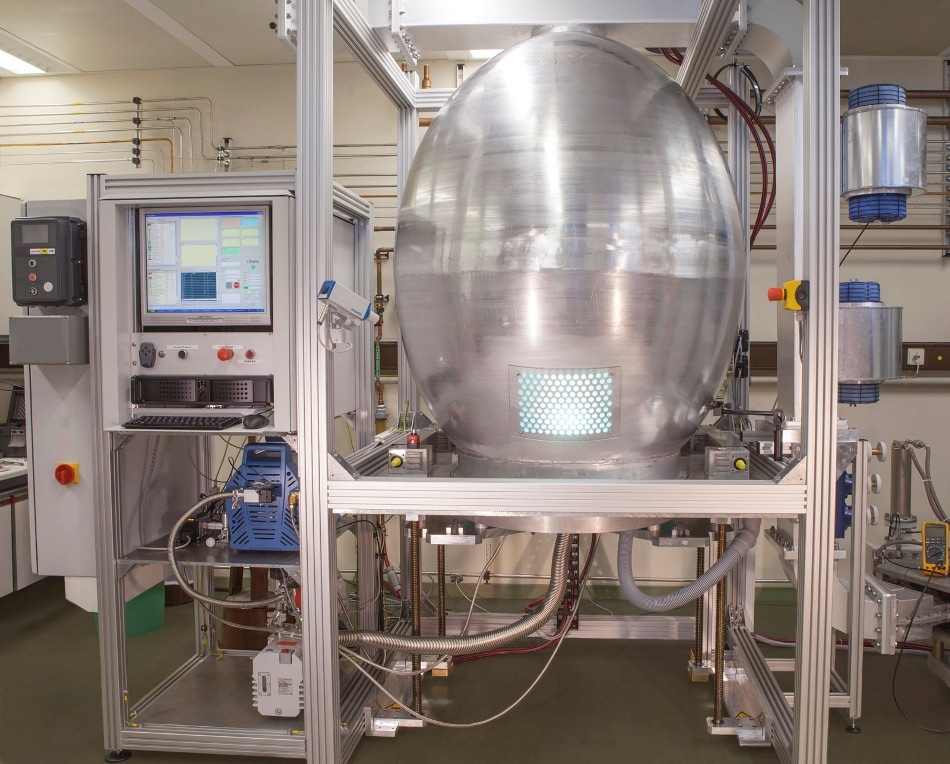Jan 4 2018
Researchers are developing a quantum sensor with the ability to accurately evaluate the tiny magnetic fields that we can expect to observe in futuristic hard disks. The size of the sensor is marginally higher than that of a nitrogen atom, where a synthetic diamond will function as a substrate.
Integrated circuitry has started to become more complicated by the day. Nowadays, there are nearly 30 million transistors in a Pentium processor. Moreover, the width of the magnetic structures seen in hard drives is merely 10-20 nm—a size much lesser than that of a flu virus (80-120 nm in diameter). Dimensions are quickly changing to the quantum physics domain and, hitherto, scientists from the Fraunhofer Institute for Applied Solid State Physics IAF in Freiburg alongside colleagues from the Max Planck Institute for Solid State Research, are working to take on the quantum technology challenges which might be encountered in the future.
 The special ellipsoid form of the plasma reactor developed at Fraunhofer IAF allows for large-scale diamond separation. (Photo credit: Fraunhofer IAF.)
The special ellipsoid form of the plasma reactor developed at Fraunhofer IAF allows for large-scale diamond separation. (Photo credit: Fraunhofer IAF.)
Aside from its outstanding chemical and mechanical stability, diamond also has a range of benefits. For example, foreign atoms such as phosphorus or boron can be implanted, thus transforming the crystals into semiconductors. Moreover, diamond is the ideal material for optical circuits. However, its best quality is its splendid thermal conductivity, as the strength of the bonds between carbon atoms ensures that heat is dissipated in a quick fashion.
In the past few decades, Fraunhofer IAF has created enhanced systems for making diamonds. The method for mass production is carried out in a plasma reactor, and Freiburg has majority of these silver-colored devices. Plasma is heated to create temperatures of 800-900 °C, so that when gas is introduced into the chamber, diamond layers are formed on the square-shaped substrate. The diamond crystals, which have an edge length of 3-8 mm, are then isolated from the substrate and polished by means of a laser.
Preparing the diamond to act as a magnetic detector
The development of the new quantum sensor mandates the use of a specifically pure crystal, which has motivated the pursuit of further advancements to the technique. To develop ultra-pure diamond layers, the methane that offers the carbon for the diamond is pre-filtered through a zirconium filter. Apart from that, the gas needs to be isotopically pure because only 12C isotope (a stable carbon isotope) has zero nuclear spin, which is a precondition for the magnetic sensor subsequently. Hydrogen is also purified, following which the ultra-pure single-crystal diamond has to be made ready for functioning as a magnetic detector. In this case, there are two choices: either a single nitrogen atom is inserted into the exceptionally fine tip, or nitrogen is added at the final stage of the diamond production procedure. Then, oxygen plasma is used for making the diamond tip sharp by means of an etching process in the institute’s own cleanroom. The eventual outcome is an exceptionally fine diamond tip that looks like the tip of an atomic force microscope. The most important factor in the entire design is the added nitrogen atom and an adjoining empty slot in the crystal structure.
This integrated nitrogen-vacancy center functions as the actual sensor, which emits light upon being exposed to microwaves and a laser. When a magnet is positioned adjacent to the sensor, its light emission is altered. Scientists term this electron spin resonance spectroscopy. Apart from detect magnetic fields with nanometer precision, the method can also ascertain their force, thereby paving the way for an exceptional range of applications. For example, the minute diamond tips can be adopted for monitoring the quality of hard drives as these data storage devices are densely packed and there might always be minute errors. The quantum sensor can recognize faulty data segments such that they are kept out of the disk reading and writing process, thereby reducing the defect rate, which has been constantly increasing due to continuous and rapid miniaturization, and minimizing the production costs.
Quantum sensors could measure brain activity
The tiny sensor can be prospectively used in a broad array of applications as there are weak magnetic fields everywhere, even in the brain. “Whenever electrons move, they generate a magnetic field,” stated Christoph Nebel, an IAF expert. Therefore, when one feels or thinks, the brains produce magnetic fields. Researchers are eager to confine this brain activity to ascertain the areas of the brain accountable for a specific feeling or function. This could be directly performed by evaluating brainwaves using electrodes. However, the outcomes are highly inaccurate. Magnetic field measurements provide well-improved outcomes. Yet, the sensors being used at present have one major drawback: they have to be cooled by using liquid nitrogen. Owing to the exceptional thermal conductivity of diamond, the innovative technology can function at room temperature without even cooling. In the case of this application, rather than using fine tips, it would be best to use tiny platelets that include multiple nitrogen-vacancy centers. Each center provides a point in the image and together a detailed picture.
However, at present, Christoph Nebel and his colleagues are concentrating on investigating and optimizing the use of diamond as a high-tech material. This usage in quantum sensor technology is an encouraging start.